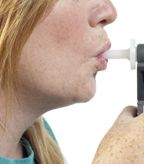A Breath Test to Screen for Colorectal Cancer?
Researchers have developed a relatively simple breath analysis testing volatile organic compounds that may one day be used as a way to screen for colorectal cancer.
Researchers have developed a relatively simple breath analysis test that may one day be used as a way to screen for colorectal cancer. Researchers at the University Aldo Moro of Bari in Italy, including Donato F. Altomare, MD, of the department of emergency and organ transplantation, have developed a way to analyze the volatile organic compounds (VOCs) found in cancer patients, but not in their healthy counterparts. This pilot study has demonstrated a different metabolite profile of those subjects with colon cancer compared to healthy subjects. The research is published in the British Journal of Surgery.

Using recently developed tools that can analyze different micromolecules that reflect the body’s cellular metabolic processes, the study authors analyzed the unique metabolite profiles of subjects using breath samples. In contrast to other types of samples from which metabolites can be processed including stool, urine, serum, and sputum, breath samples are noninvasive and are projected to have a high patient compliance.
Because cell metabolism is altered in cancer cells, the molecular products and byproducts they produce are different from normal cells, in quality and quantity.
The Study Design
Altomare and colleagues first identified specific VOCs that may differ between patients with colon cancer and those who are cancer-free. The most likely VOCs among cancer patients are likely reactive oxygen species, among others. These metabolites, in theory, travel from their origin within the body to the lungs where they are exhaled, according to the authors.
Almost all the molecules the researchers identified “can be found in the breath of healthy people,” said Altomare, but in cancer patients, “their proportion or pattern is changed.”
Breath samples were collected from 37 patients with colon cancer prior to their undergoing surgery for their cancer. Patients with comorbidities such as diabetes and other diseases were excluded so as to not confound the metabolite analysis. The samples of these patients were compared to 41 healthy controls who had undergone a colon cancer screening and found to be disease-free. All samples were analyzed using gas chromatography linked to mass spectrometry.
The initial analysis identified 15 different VOCs, out of 58 total, that could differentiate between cancer-positive and negative individuals. There were no sex-based differences among the VOC profiles nor did the profiles distinguish between early- and late-stage colon cancer patients.
Statistical analysis showed that the VOC profile had an 85% predictive accuracy, an 86% sensitivity, and a specificity of 83%. The analysis resulted in five false negatives and seven false positives.
Using a follow-up, independent and blinded cohort of 15 colorectal cancer patients and 10 noncancer controls, the accuracy of the test was 76%. Three false positives and three false negatives occurred.
Lower cost, easy to execute screening procedures are needed for colon cancer that could rival the sensitivity and specificity of colonoscopies. Colon cancer is the third leading cause of death from cancer in the United States and the second in Europe.
“We do hope this proportion could further improve with the availability of new devices to collect the breath sample and with further studies to understand the specificity of the pattern of VOCs identified compared to the disease's state,” Altomare said. Altomare added that this accuracy is already better than traditional screening tests such at the fecal occult blood test and immunochemistry-based tests.
While differential VOC patterns have been demonstrated for lung, prostate, breast, and colorectal cancers as well as for melanoma and hepatocellular carcinoma, among others, this is the first clinical assessment of VOCs in colorectal patients compared with their non-cancer counterparts, according to Altomare. This study is also the first to identify a specific pattern of VOCs in cancer patients.
The collected breath samples need to be analyzed within a few days using specialized equipment including gas chromatography and mass spectrometry as well as computer statistical software.
This study provides early support for this screening method, but this technique is still in the early stages of development, in part because the field of analyzing many metabolic molecules, called “metabolomics” is fairly new. Further development of the technique and much more testing is necessary. A recent study has also demonstrated that the breath of cancer patients-breast, lung, colorectal, and prostate-is distinct from noncancer subjects.
The authors of the current study note that this tool could also be useful to diagnose benign gastrointestinal disorders such as lactose intolerance and cystic fibrosis, among others. However, since each disease appears to have a different VOC profile, analysis of these different diseases will be distinct.
A larger study is being planned that will also look for new ways to analyze the results, according to Altomare. A comparison of the breath test with the fecal occult blood test as well as developing the test to detect colonic polyps are also in the works.
“Studies to set up an electronic nose is underway in collaboration with Gianluigi de Gennaro from the chemical department of University of Bari, which we hope will further make the colorectal cancer screening by breath analysis easier and available as a screening tool for the general population,” said Altomare.